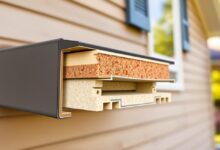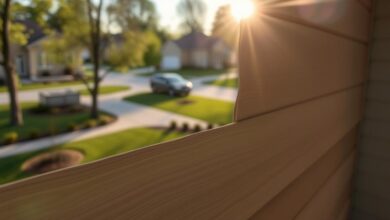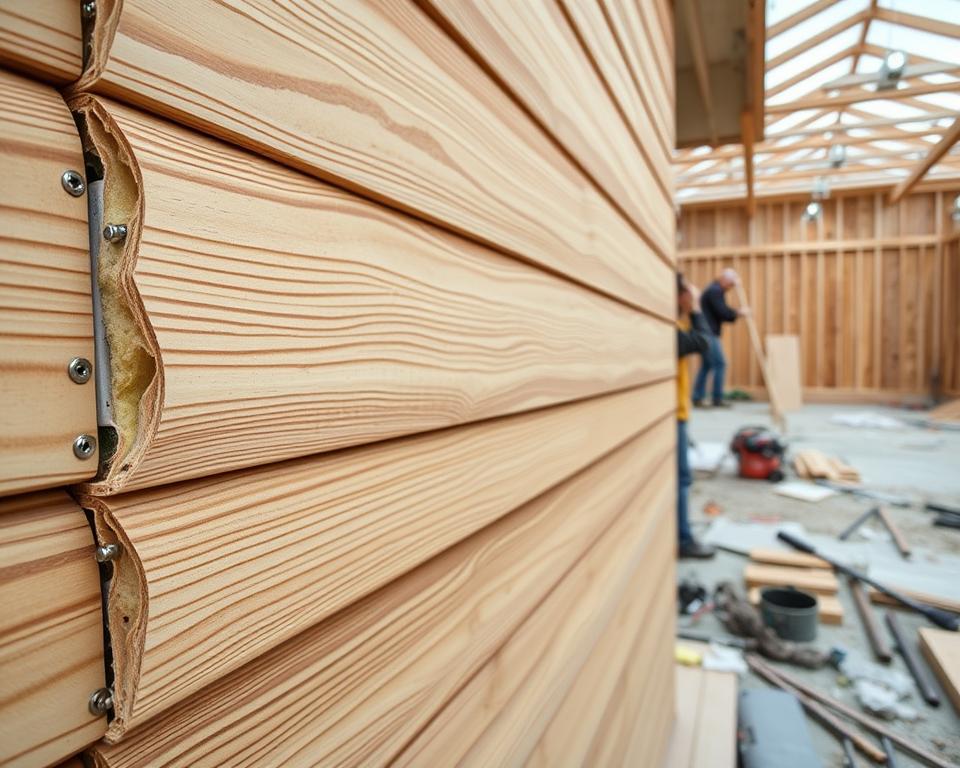Maintain Insulated Siding: A Step-by-Step Guide
Keeping your home’s exterior in good shape is key for its look and life. A big part of exterior home maintenance is making sure your insulated siding is up to par.
Insulated siding boosts your home’s energy use and guards it against bad weather. But, it needs regular care to work right.
This article will show you how to keep your insulated siding in great condition. We’ll cover important tasks and tips to care for your home’s outside.
Key Takeaways
- Understand the importance of maintaining insulated siding for your home’s longevity.
- Learn the essential steps to maintain your insulated siding effectively.
- Discover tips to enhance your home’s energy efficiency through proper siding maintenance.
- Identify common issues with insulated siding and how to address them.
- Gain insights into the benefits of regular exterior home maintenance.
Understanding Insulated Siding and Its Benefits
Insulated siding brings many advantages, like better energy use and stronger home protection. It’s made to last and save energy for homeowners.
What Makes Insulated Siding Different
Insulated siding stands out because it has a foam backing. This backing boosts its ability to keep temperatures steady inside. It stops heat from moving between the inside and outside of your home.
Types of Insulated Siding Materials
Insulated siding comes in different materials like vinyl, fiber cement, and engineered wood. Each has its own strengths, like how long it lasts, how easy it is to care for, and how it looks.
Energy Efficiency and Home Protection Benefits
Insulated siding helps save on heating and cooling costs. It also protects your home from bad weather. It keeps your home safe from rain and snow pushed by wind.
| Material | Durability | Maintenance |
|---|---|---|
| Vinyl | High | Low |
| Fiber Cement | High | Medium |
| Engineered Wood | Medium | High |
Essential Tools and Materials for Siding Maintenance
To keep your insulated siding in top shape, you need the right tools. Let’s look at what you’ll need to get the job done right.
Cleaning Supplies You’ll Need
Start with a soft-bristle brush or a soft cloth to clean without damage. Mix a mild detergent with water for cleaning. Stay away from harsh chemicals that can ruin the siding’s finish.
Inspection and Repair Tools
For checking your siding, use a ladder to reach all spots. A flashlight helps light up dark areas. For fixing things, have a caulk gun and matching caulk ready.
Safety Equipment Recommendations
Remember to wear safety goggles and gloves to protect yourself. A dust mask is also smart when using power tools or chemicals.
How to Maintain Insulated Siding: Regular Cleaning Procedures
Keeping insulated siding in good shape means cleaning it regularly. This prevents damage and keeps your home energy-efficient. Cleaning also makes your home look better and keeps the siding working well.
Step1: Preparing the Surface Area
First, clean off any debris like twigs or leaves from the siding. Use a soft-bristled brush or cloth to remove dirt and cobwebs. This makes sure your cleaning solution can get to all parts of the siding.
Step2: Gentle Washing Techniques
Mix a mild detergent with water for your cleaning solution. Use a soft-bristled brush or a low-pressure washer to apply it. Don’t use high-pressure washes because they can harm the siding. Gentle cleaning is key to avoid damaging the siding’s surface.
Step3: Dealing with Stubborn Stains and Mildew
For tough stains or mildew, mix bleach with water. Apply it to the problem area and wait a few minutes before rinsing. Be careful with how much bleach you use to avoid harming the siding.
Step4: Proper Rinsing Methods
After cleaning, rinse the siding well with clean water. Use a garden hose with a spray nozzle to make sure everything is clean. Rinsing properly stops soap residue from attracting dirt and causing streaks.
What Cleaning Products to Avoid
Stay away from harsh chemicals, abrasive cleaners, and strong detergents. Only use bleach for mildew or tough stains, and always mix it with water. This protects your siding from damage.
Seasonal Inspection and Maintenance Routines
Seasonal inspections are key to keeping your insulated siding in top shape all year. By sticking to a maintenance schedule, you can avoid seasonal damage. This helps your siding last longer.
Spring Maintenance Checklist
When spring comes, check your siding for winter damage. Look for loose or missing panels and signs of water damage. Clean it gently with a solution to remove winter dirt.
- Inspect for loose or damaged panels
- Check for water damage or moisture
- Clean siding with a gentle solution
Summer Protection Strategies
In summer, your siding faces strong sunlight and heat. Make sure it’s sealed well to keep heat out. Use a siding cleaner with UV protection to keep its color and quality.
Key summer protection tips:
- Ensure siding is properly sealed
- Use a siding cleaner with UV protection
Fall Preparation for Winter
As fall comes, get your siding ready for winter. Check for damage or gaps and seal them. Also, clear leaves and debris to ensure good drainage.
- Inspect and seal any gaps or damage
- Clear leaves and debris
Winter Monitoring Tips
In winter, watch for siding damage from snow, ice, or cold. Keep gutters clear to prevent ice dams.
Monitor for:
- Signs of snow or ice damage
- Ice dams in gutters
Repairing Common Insulated Siding Issues
Keeping your insulated siding in good shape is key. Knowing how to fix common problems can make it last longer. Issues like cracks, water damage, and bugs can happen over time. Fixing these problems quickly helps keep your home looking great.
Fixing Small Cracks and Holes
Small cracks and holes can be fixed with caulk or spray foam made for the outside. First, clean the area well to get rid of dirt. Then, apply the caulk or foam to fill the gap. Make sure it’s smooth and let it dry as the maker says.
Addressing Water Damage and Moisture Issues
Water damage and moisture can cause big problems if not fixed. Check your siding for signs of water damage like warping or color changes. To fix, find and fix the moisture source, then replace the siding. Make sure windows and doors are sealed well to stop water from getting in.
Repairing Loose or Damaged Panels
Loose or damaged panels can weaken your siding. Start by taking out the bad panel. Check the area underneath for damage and fix it if needed. Put in a new panel, making sure it fits well and is securely attached.
Dealing with Insect Damage
Insects can harm your siding, mainly if it attracts them. Look for signs of bugs like holes or tunnels. To fix, remove the damaged part and treat the area with bug spray. Then, replace the siding with new material.
When to Call a Professional
While you can fix some things yourself, some jobs need a pro. If the damage is big or you’re not sure what to do, get a siding repair expert. They can figure out the best way to fix your siding and keep it working well.
| Issue | DIY Repair | Professional Help |
|---|---|---|
| Small Cracks/Holes | Yes | No |
| Water Damage | Sometimes | Yes |
| Insect Damage | Sometimes | Yes |
| Loose/Damaged Panels | Yes | Yes |
Extending the Lifespan of Your Insulated Siding
To make your insulated siding last longer, follow a few easy steps. Focus on prevention, landscaping, and keeping water away. These steps can really help your siding last.
Preventative Measures for Long-Term Protection
Regular checks and upkeep are vital to keep your siding in good shape. Look for cracks, dents, or fading. Fix any gaps or cracks right away to stop water damage.
As
“Regular maintenance is essential to extending the life of your insulated siding. It’s a proactive approach that saves time and money in the long run.”
Choosing the right cleaning products and avoiding harsh chemicals also helps your siding last longer.
Landscaping Considerations to Protect Siding
Your landscaping choices can affect your siding. Keep plants and trees away from your home to avoid damage. Trimming back vegetation often is a smart move.
| Landscaping Tip | Benefit |
|---|---|
| Keep plants away from the house | Reduces debris accumulation |
| Trim branches regularly | Prevents physical damage |
Maintaining Proper Drainage Around Your Home
Good drainage is key to avoiding water damage to your siding. Clean your gutters often and make sure downspouts direct water away from your foundation.
By taking these steps, you can protect your siding from water damage. Proper drainage is a must for keeping your home in good shape.
Conclusion
Keeping your home’s exterior in good shape is key to protecting your investment. This ensures your home looks great and stays safe. By following our guide, your insulated siding will stay efficient and protect your home for many years.
Good insulated siding care means regular cleaning and checking it out seasonally. Fixing any problems right away is also important. This helps avoid damage, saves on energy costs, and keeps your home’s value up.
Exterior home care might seem hard, but it’s doable if you break it down. Adding these steps to your routine will keep your home’s exterior looking and working well. This boosts your property’s look and function.
Focus on keeping your insulated siding and home exterior in top shape. This will shield your home from the weather and keep its value high over time.







